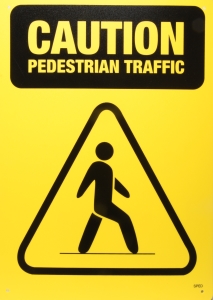
Trainers are often tasked with keeping a training session interesting by encouraging group discussion. A common method to do this is to bring up 'hot button' topics that people feel strongly toward and react accordingly.
One of my favorite hot buttons is the right-of-way issue: it can be an entertaining and occasionally frightening topic to broach. Metaphorically - it's like pulling the pin of a grenade and tossing it into the center of the room; reactions are guaranteed and virtually instant!
Most people relate to both sides of the issue here because most of us have been a vehicle (like a car) operator and a pedestrian. When we drive our cars, or forklifts as the case may be, we cannot understand how those darn pedestrians can be so careless as to not understand the issues we are dealing with as operators and of course when we are pedestrians, we cannot fathom the incompetence of an operator who is not mindful of us.
At most industrial operations I have been to, the people there come down on the equipment "side" of things. They award the right-of way to the equipment using the rationale that operators have visibility, load handling and braking issues to deal with, and the last thing they need to be worried about is where a pedestrian will appear or what they may do. However on the legal/liability side of things, the law typically comes down on the pedestrian's side of things often citing the premise that life should always have the right-of-way over machinery.
Personally, I don't like the idea of either operators or pedestrians believing that they have the absolute right-of-way so I try to instill a more cooperative frame of mind in both. Many operators who believe they have the right of way tend to operate with a certain devil-may-care attitude which may not necessarily be careless, but is dangerous. Likewise, pedestrians with the belief that they have the right-of-way often behave around mobile equipment carelessly, oblivious to their surroundings and always unpredictable.
To operators I say that it is they who are required to be in control of the equipment at all times and operate in such a way that offers maximum visibility (load trailing wherever possible) with the ability to stop under all conditions, including pedestrian-heavy areas. If push comes to shove, even though company policy may favor operators, the law usually doesn't and if they hit someone, the law will be there, usually in the form of lawyers.
To pedestrians I say that although the law is usually on their side in many cases, if a collision occurs your family may win a lawsuit and be able to afford to plant you in a nice oak box instead of the standard pine one - congratulations. Sometimes I have found it useful to sit a pedestrian behind the wheel of a loaded forklift in hopes of giving them some glimpse of an operator's perspective. It's usually quite effective.
The fact of the matter is that we all need to look out for each other and try to respect what the other is dealing with. Toward that end, pedestrians and operators alike may benefit from adopting a 'neither has the right of way' philosophy or better still, safety has the right of way.
Of course, communication between operators and pedestrians is vital. When the two meet each other both should stop, make eye contact and acknowledge one another, then offer some sort of signal (a wave, nod, horn, gesture, etc), preferably the operator waving the pedestrian through in most cases. Hi-visibility clothing, clearly marked walkways, signage, mirrors all have their place and contribute to managing risk.
Finally, winning the hearts and minds of the people involved in such a way that attitude and behavior are favorably influenced is paramount because policy and procedure can do nothing without people to make them work.
Rob Vetter
Director of Training
IVES Training Group
Did you enjoy this article? Sign up for our newsletter to receive more like this!